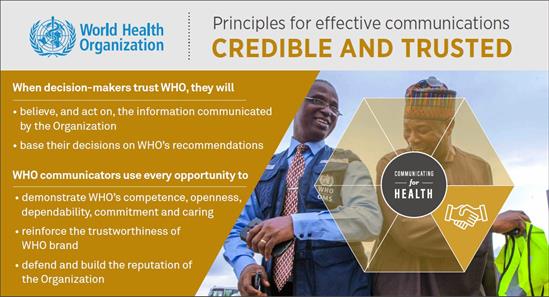
Principle: Credible and trusted
WHO brand
Tactics to apply to make your communications credible and trusted
Using the WHO brand for maximum impact
Decision-makers use health information, advice and guidance from trusted organizations that have a strong reputation for competence. WHO communications are designed to communicate health information in ways that protect and enhance WHO’s reputation as a source of credible information on chronic and emergency health issues.
Protect the WHO brand and intellectual property
Consistent branding of WHO content across all channels and levels of the Organization helps maintain trust in WHO.
- The WHO eManual, section VIII, and the web Emblem and Programme Logo Policy provide guidance on when and how to use the WHO logo and programme-specific logos.
- Visual identity guidelines detail how to use the WHO logo and provide links to graphic files.
- Partners that use and appropriately cite WHO information and guidance enhance WHO credibility.
- Appropriate use of social media can enhance the brand, but staff must know how to avoid negatively affecting the Organization when posting to their personal social media accounts.
- WHO provides employee training and policies on corporate and personal use of social media, helping staff use these channels in ways that support WHO activities.
Amplify WHO messages to influence global health policy
WHO employees are the most credible voices of the Organization. Their voices amplify the global WHO role and message.
- In the 2015 WHO global perception survey, 81% of employees said they would speak positively about WHO.
- The Director-General, Assistant Director-General, regional directors and senior staff are key voices representing WHO priorities at important events.
- All staff can use training resources to be more effective WHO ambassadors: The Effective Communications Participant Handbook, iLearn Communication Essentials, and the training module, “Telling the WHO Story”.
Prepare and support spokespeople
Communicators ensure that WHO spokespeople are prepared to represent the Organization when speaking to the media or at conferences. They can provide the following support services.
- Talking points, which are brief statements written in speaking style. They help spokespeople convey key messages and facts.
- Media training to provide guidance and opportunities to practice for interviews across a variety of platforms, including television, radio, Skype and social media.
- Background information on journalists and media outlets to help spokespeople prepare for interviews. Before an interview, spokespeople should know the focus of the interview and any prior relevant coverage.
- Spokespersons are encouraged to use DCO and regional and country communication officers to help prepare them for speaking roles at public and partner engagements.







